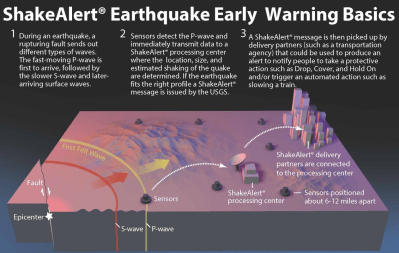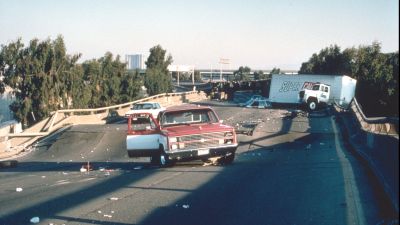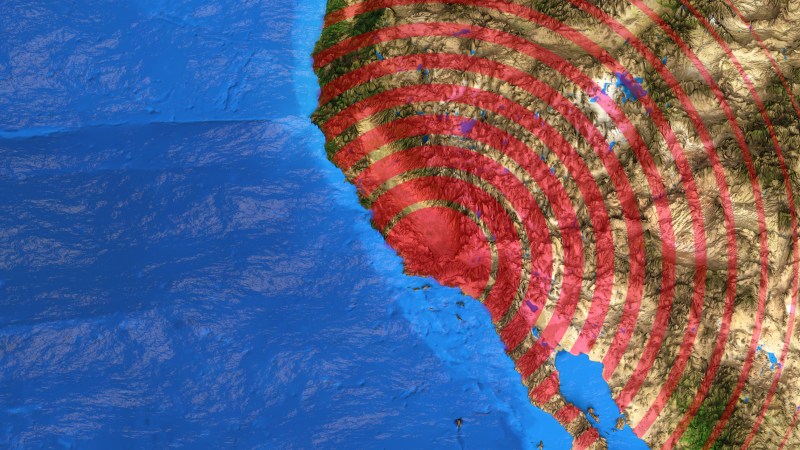Earthquakes are highly destructive when they strike, and unlike many other natural disasters, they often hit with minimal warning. Unlike hurricanes and floods, and even volcanoes to an extent, earthquakes can be very difficult to predict. However, in recent decades, warning networks have proliferated around the world, aiming to protect affected communities from the worst outcomes in the event of a large tremor.
ShakeAlert is the name of the earthquake monitoring project run by the United States Geological Survey, which has just announced that it now offers early warning services to the entire west coast of the United States. Let’s take a look at how earthquake monitoring works, how that feeds into early warnings, and how this can make a difference in the case of a major quake.
Seconds, Not Minutes
When an earthquake begins at a geological fault line, it produces a variety of types of waves, known as primary waves (P-waves), secondary waves (S-waves), and various types of surface waves. P-waves travel at roughly 5-8 kilometers per second, around 1.7 times faster than S-waves, and rarely cause major damage. Surface waves are typically slower again. Thus, by monitoring seismographs for characteristic P-waves, it’s possible to get an advance warning that nastier shakes are coming.

Depending on the distance from the seismograph to the quake’s epicenter, the warning time can be anywhere from a few seconds to a minute or two at most. In the case of ShakeAlert on the West Coast of the United States, the USGS estimates the system will provide up to ten seconds of warning to users’ phones in the event of a magnitude 5 quake or greater.
This time is based on the proximity of cities to the fault lines themselves, with shorter distances to the quake epicenter providing less time for the P-wave to get out ahead as an early warning for the coming S-wave. This contrasts with the early warning system set up in Mexico City; with the population center much farther from the epicenter of typical quakes, past tremors have seen citizens given from 20 seconds to 2 minutes of warning prior to the arrival of the stronger-shaking S-waves.
A Few Spare Seconds Make a Big Difference

Ten seconds may not sound like a lot of time, especially given that most users will receive warnings via smartphone. However, in many cases, it’s still enough to make a valuable difference. It only takes a few seconds to climb down off a ladder, switch off dangerous machinery, duck away from windows, or crouch in an emergency exit and hang on to the wall. These simple measures alone can save thousands of injuries across a city affected by an earthquake. It’s similar to the unfairly maligned Duck and Cover method from the 1950s, designed to help minimise casualties in the event of a nuclear blast. Simply getting low to the ground and avoiding falling objects and breaking glass in the event of an earthquake can leave you feeling far happier in the immediate aftermath of the event. Footage from the 1989 San Francisco earthquake shows people reacting with confusion and delay when the rumbling starts. A ten second warning, combined with the knowledge to drop, find cover, and hold on, would have made a significant difference to many.

A further boon of the system is that it can be set up to automatically take preventative actions in the event of detecting an earthquake. Earthquakes can cause havoc to infrastructure, with violent shaking cracking water and gas pipes, and even jamming doors shut at fire stations and other emergency facilities. At best, this adds frustration in an already difficult time; at worst, it puts lives at risk and exponentially increases the damage bill racked up by the quake. With a properly configured warning system in place, however, this can be avoided. Since the first systems were installed in the US in the early 2000s, they’ve been used to automatically open doors and raise sirens at fire stations, as well as set up to switch off valves in gas and water lines to prevent leaks and damage. In fact, one of the first ever earthquake warning systems in the world was UrEDAS, or Urgent Earthquake Detection and Alarm System, used by Japan’s railways to slow down high speed trains in the event of an earthquake detection. This was the first system to use P-wave sensing for earlier warning of pending earthquake events.
ShakeAlert won’t be able to prevent all the negative impacts of future earthquakes. It will still take time to detect quakes, so the places nearest the epicenter will still face damage without warning. However, it should serve as a capable tool that does help reduce the overall pain and suffering of earthquakes on the West Coast on a grander scale. With similar systems already proving their worth in Japan and Mexico, expect them to become a regular fixture in earthquake-prone regions around the world.

















I wonder if our alert system is up to the task. My wife and I often observe that one of us will get an amber alert message on one phone, and then hours or most of a day later the other will get it. Not sure we are at anything like 10 second resolution to all residents.
SMS alerts are unreliable. I live on east side of Michigan, USA and once I got amber alert from a situation from west side of Michigan, last seen heading west toward Chicago. Another time there was a kidnapping maybe 30 minutes from where I was, no AA came to my phone at all but my parents who lives in the same city did get their AA. I did check, the location was enabled and I was in correct city according to Google map.
Another time AA showed up on my phone 24 hours after the situation ended. I would say 99% of the time SMS gets through fine and 1% it just gets stuck for a while or lost into digital void.
If someone lived alone in earthquake area and was that 1% with delayed or missing SMS alert, sucks to be him or her. I hope there are other means of sending emergency message and not rely only on SMS.
Probably not. AFAICT, cell phone alerts will be pushed though IPAWS OPEN, which is basically an ATOM feed that WEA and EAS participants have to periodically poll. That’s right–there’s no push capability, and I believe you’re supposed to rate-limit your polling to avoid DoSing FEMA’s servers. I suspect the servers are pretty fragile because you need a signed MOU with DHS/FEMA to even access the feed.
Once the carrier gets the alert, it should go out fairly quickly. In ye olde GSM networks, this was done via Cell Broadcast, which is basically a broadcast mode of SMS. In LTE, there’s a dedicated System Information Block (12) that is constantly transmitted which contains the current alert, so your phone should pick it up quickly, and perhaps even if it doesn’t have service.
However, supposedly this is secondary to some other unspecified mechanism that ShakeAlert uses to push out alerts, and THAT system will be used by critical infrastructure, etc. Supposedly Google also has access to this system and push alerts out through Play Services, and given the sheer volume of push notifications they send out, I suspect they’re up to the task (as long as the cell networks are).
Probably not, but Apple can get a push notification to my phone in about a second – and I imagine Google’s push notifications are similarly fast?
Man I thought this was that 3D printed seismometer project. Beh!
I actually us the app from emsc-csem.org and have found within seconds or a minute I am getting the alert. I am often in Turkey an have been sat at the bar having a drink.. my drink gets the wobbles and then phones of the app users going off in the bar.. Though the weirdest feeling was when i was scuba diving at 40m (132ft for the yanks) I not so much felt it but heard it throughout my body. we all surfaced after that. once back on boat our phones showed a 5.4 only 20 miles away in the agean sea
( I have found good lashings of rum to be a good decompression agent after a days diving when the sun is setting) .
the dive guide did ask did you hear the cracking and ticking before the quake.
you accidentally became a seismometer, good job!
i have to ask- what did the quake sound like?
And that’s why you always bring a waterproof sound recorder with you.
P waves, makes sense. Even a person can feel those waves – which is a very weird sensation but in my experience they give you so iittle heads up time there is not much you can do. except brace for the quake.
And those P waves travel. I remember the recent Trona quake, even though I was 75 miles from it, I could still feel the P wave come through seconds before the real quake began(which broke a lot of residential water pipes as well).
Something doesn’t sound right about an earthquake warning system that heavily uses text messages or multi-cast mobile network. Do we really want to fill our west coast mobile networks with 60 million identical text messages in the fleeting seconds before that network goes down? Are people going to spend the remaining few seconds fiddling with their phone if they pay attention at all? What about all the people that don’t have their phone with them? What about the response systems that need the final moments of bandwidth to respond to the alert?
I hope the municipalities have regularly tested community siren systems in place that are triggered an instant before the mobile network system is flooded with traffic. (I know here is Seattle I’ve not heard a civil defense siren test for at least a few years.) — Similarly broadcasters should be informed early.
I hope this is all being considered.
I can give you more warning that that, the wrath of Juan de Fuca is going to destroy your world California. Prepare to leave now, permanently, while you can still find fools to buy your property.
Geez, go read a book on plate tectonics. Why would a subduction zone next to the boonies of north-most California destroy my world? I am not a geologist, but am not convinced that even the San Andreas (which is a lateral transform and not a subduction) is a principal risk to my world. The danger is the several major faults that parallel the San Andreas. Typical examples are the Elsinore and San Jacinto fault systems in Southern California. As they connect both the peninsular ranges and the transverse ranges, and exhibit less than 5mm motion per year, your focus should be obvious.
As for the coming ‘big one’, I am looking forward to the event and its resultant. Less people, decreased real estate costs, less traffic, less infrastructure, less noise, cleaner air, less stress on water sources, etc.
Go and read a few books yourself, it has happened before in that region and indian tribes along the entire west coast of the USA have stories of what happened to those who lived near the coast and didn’t make it to high ground fast enough. This has in fact been looked into at a serious level.
yeah 10 second warning if you live 200 miles away where the quake wont do any damage anyway. 0 second warning or 1 second warning if you live 5 miles away where it will do the most damage.
Just a few thoughts to perhaps stimulate some ideas:
1. There has been ongoing activity along the Cascadia zone recently, and it would be inaccurate to describe it as trivial. Check out “the mystery tsunami” of January 1700 when a wave took out an entire town in Japan- the cause was eventually attributed to a magnitude 9 quake in what is now Washington state. Additional info: search on “ghost forest”.
2. There is something curious about the CA early alert system. Knowing several people who have attempted to participate by attending “briefings” reveals that whatever has been developed is specific to cell phone notification and commercial shutdown systems; there is no provision (or intent) to provide alerts to the general public by other means, although such could be done as a subcarrier or embedded data on the existing network of weather stations. No available signals on air or on internet outside of their custom service as yet. And inquiries along those lines are simply ignored.
3.Coincidentally enough, there was a sequence of moderate quakes at the south end of Salton Sea earlier today that probably deserve some attention but will likely not breach the news threshold. Might be nothing but a swarm, might be foreshocks. Should we just wait to find out? Can additional interest be generated by localized real-time data?
4. Previous attempts at creating a seismic network using amateur radio and homebrew sensors has been sporadic at best. In fact, at one point (before CalTech developed direct-to-satellite capability) there were plans to co-locate links at repeater sites around SoCal to relay remote sensor data back to Pasadena. Never materialized, but the concept was valid. Now the challenge is laid down as to how emcomm providers can acquire and interface with some kind of seismo data to provide additional notification systems to various support groups. Ham installations are in place, including mesh nodes. Nets of volunteer communicators occur regularly. Might be time for a next-step? Any takers?